How to Recover Deleted Excel Sheet in Windows 10

Microsoft Excel is considered by many to be the standard in spreadsheet programs available for use on Windows 10 computers. Countless individuals and organizations use Excel to store important information including financial and other sensitive data. Excel spreadsheets are the kinds of files that you want to protect.
Unfortunately, it is very easy to unexpectedly lose or delete one of these valuable items. It can happen due to human error, malware, or events completely out of your control. Don't panic. We are going to show you how to recover your lost or unsaved Excel files on Windows 10 machines.
Quick Navigation:
| Problem | Solution |
| I didn't save the Excel file. Popular | Recovering an unsaved Excel file |
| I recently deleted the Excel file. | Recover from the Recycle Bin Recover from a backup Recover with data recovery software |
| I deleted the file and it's not in the Recycle Bin. Popular | Recover with data recovery software |
| My Excel crashed and I didn't save the file. | Recovering an unsaved Excel file Recover from a backup |
| I want to recover an accidentally closed Excel file. | Recovering an unsaved Excel file |
| I need to recover an Excel file that was saved over. | Recovering an overwritten Excel file with Previous Versions Recover from a backup |
Recovering an Unsaved Excel File
You can run into the problem of needing to recover an Excel file that has not been saved for several reasons. Among them are:
- Human error – You might have closed an Excel document without saving your file.
- Application failure – The program can sometimes hang, making it necessary to perform a force quit which may result in an unsaved Excel file.
- PC crash – Your machine might suddenly stop working, leaving you with unsaved Excel files after the crash.
Luckily, Microsoft has built an autosave function into the app that can help you get back an unsaved file. It's called AutoRecover and here's how to use it to get back an Excel file that was not saved.
- Launch Excel and go to the File tab.
- Click Open and then select the Recent Workbooks option on the top left.
- Scroll down and click the Recover Unsaved Workbooks button.
- Locate the lost file and double-click it to open the document.
- The file will open in Excel and you can use the Save As option to save it to your desired location.
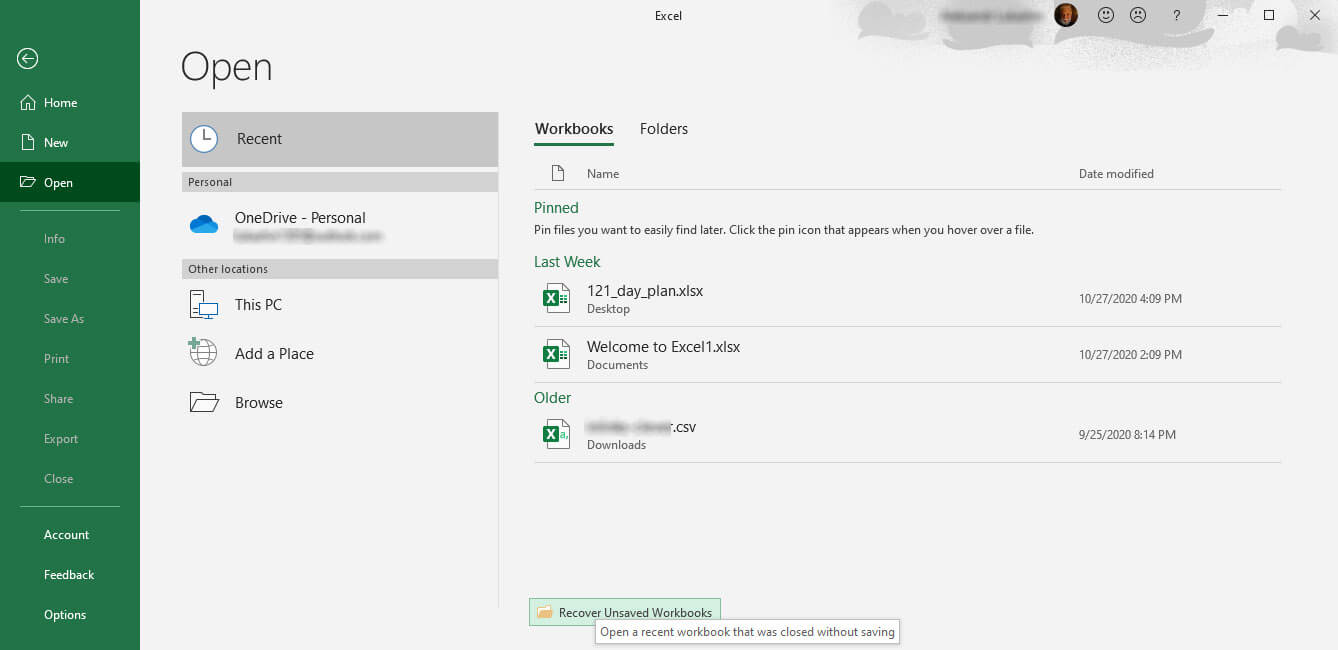
You need to configure the AutoRecover settings in Excel to use the feature. You can control how often files are saved automatically or turn off the feature if you don't want to use it. We recommend that you turn it on and set the save interval to a small number that eliminates the possibility of losing a lot of unsaved work. Use the following steps to configure AutoRecover in Excel.
- Go to the File tab and choose Options.
- Click on the Save tab.
- Ensure that both the 'Save AutoRecover information every X minutes' and 'Keep the last autosaved version if I close without saving' are checked.
- Click on OK.
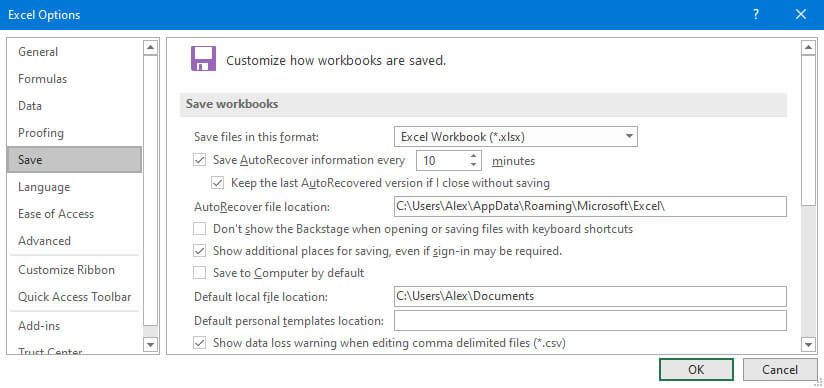
How to Recover Deleted Excel Files
If you are faced with a lost or deleted Excel file, there are several methods with which you can attempt to recover it.
The Windows Recycle Bin
The first place to look for a lost Excel file is the Windows Recycle Bin. The developers of the world's most popular operating system knew that accidents can happen. It's very easy to accidentally delete an important file that you immediately realize you need. The Recycle Bin was designed to take care of that.
There is no mystery to the Recycle Bin. It is merely a special folder that the Windows operating system uses to temporarily store deleted items. Here's how to recover a deleted Excel file using the Recycle Bin.
- Open the Recycle Bin.
- Locate the item you want to retrieve.
- Right-click on the item and select the Restore option.
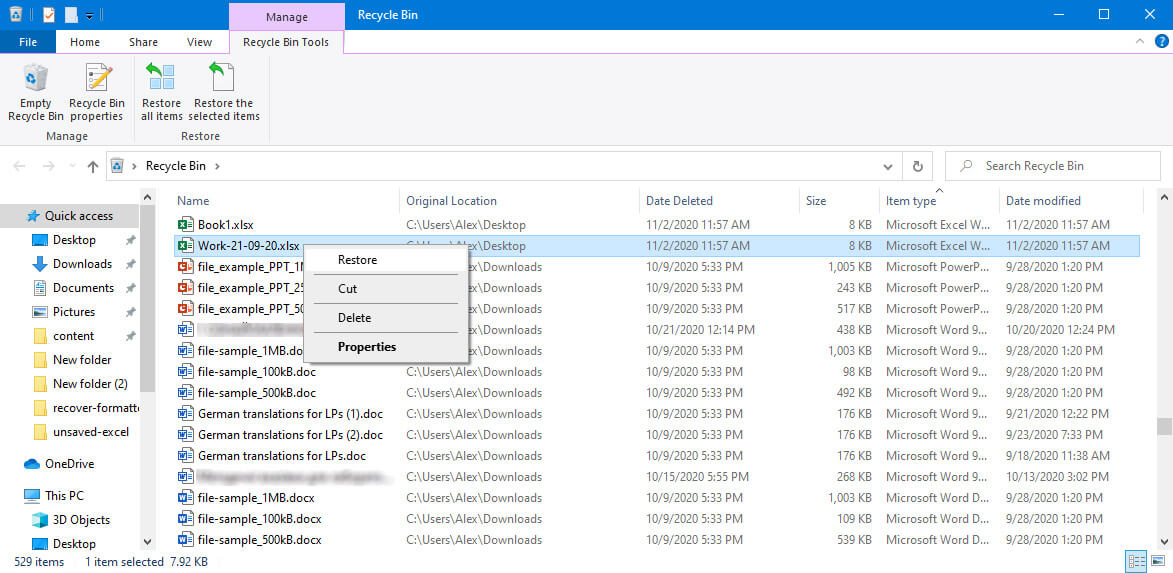
The Excel file will be restored to its previous location where it can be used as if it was never lost.
Backups
It is considered best practice for all computer users to regularly back up their data. This can be done through the native Windows operating system facility known as File History. You can also use other third-party backup solutions including backing up to the cloud. For this discussion, we will use backups made with File History as the media used to recover a deleted Excel file. For more information regarding backing up your Windows 10 system in this way, check out this site.
Follow these steps to recover files backed up by File History. Alternative backup and recovery solutions will use a similar procedure.
- In the taskbar's search box, type restore files.
- Select Restore your files with File History.
- Locate the file you want to recover and use the arrow keys to see what versions are available.
- Select Restore to recover the file to its original location, or Restore to if you wish to save it to a different place.
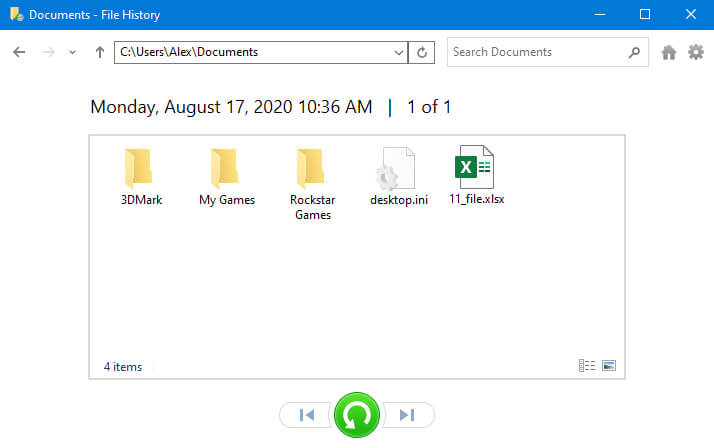
For this method to work, you need to have backed up the file in question. If changes were made to the document since the last backup, you may lose some data but can still get back most of your information that was saved in the original file.
Data Recovery Software
You will not be able to recover your lost Excel file from the Recycle Bin if it has been emptied, which permanently deletes the items in the bin. If you don't have a backup or it's too old to be helpful, you can use data recovery software to restore a deleted Excel document or sheet.
Data recovery software takes advantage of the way the Windows OS deletes data. When the operating system deletes a file from your computer, it does not physically remove the data. It simply deletes the logical links to the data and marks the space formerly occupied by the item as available for use when needed to save new information.
Until the original file or folder is overwritten by new data, it can be recovered by data recovery software. The application scans a storage device and repairs the logical links, making the data accessible to the operating system and other programs. The key is to use data recovery software quickly before the original files are overwritten.
There are many data recovery products on the market. They distinguish themselves by the reliability of their recovery algorithms and the ease-of-use provided by their user interfaces. We have used many of these recovery applications over the years, and have had great success using Disk Drill Data Recovery from CleverFiles. It provides users with a simple recovery method that has been proven reliable time after time.
The following steps demonstrate how to recover an Excel file using this flexible software tool.
- Download and install Disk Drill.
- Select the storage device that contained the deleted files.
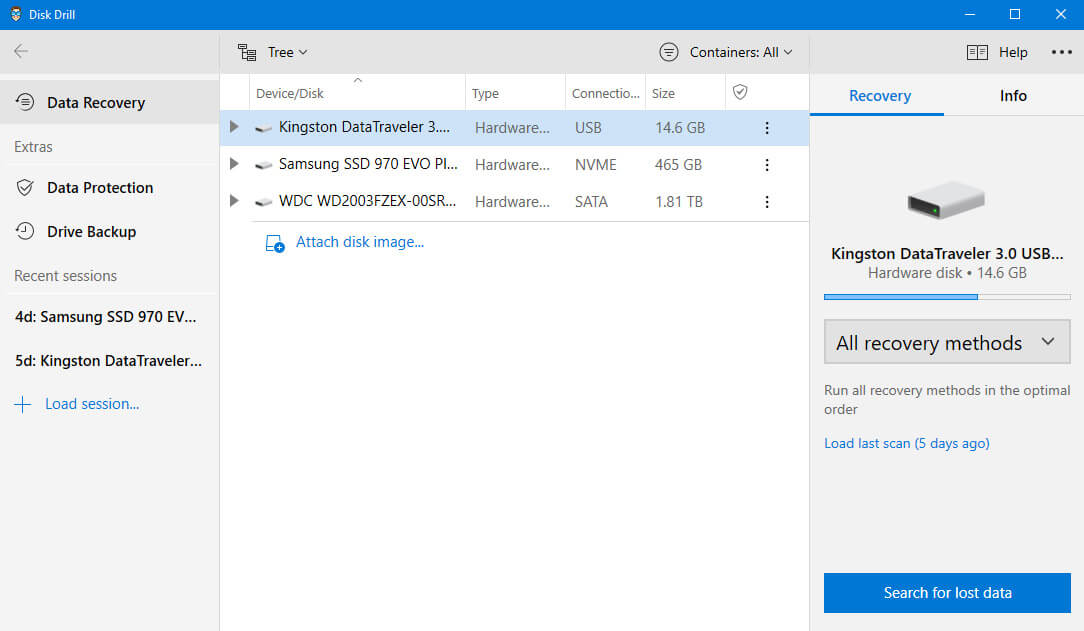
- Scan for lost data using Disk Drill's sophisticated recovery algorithms with just a click of a button.
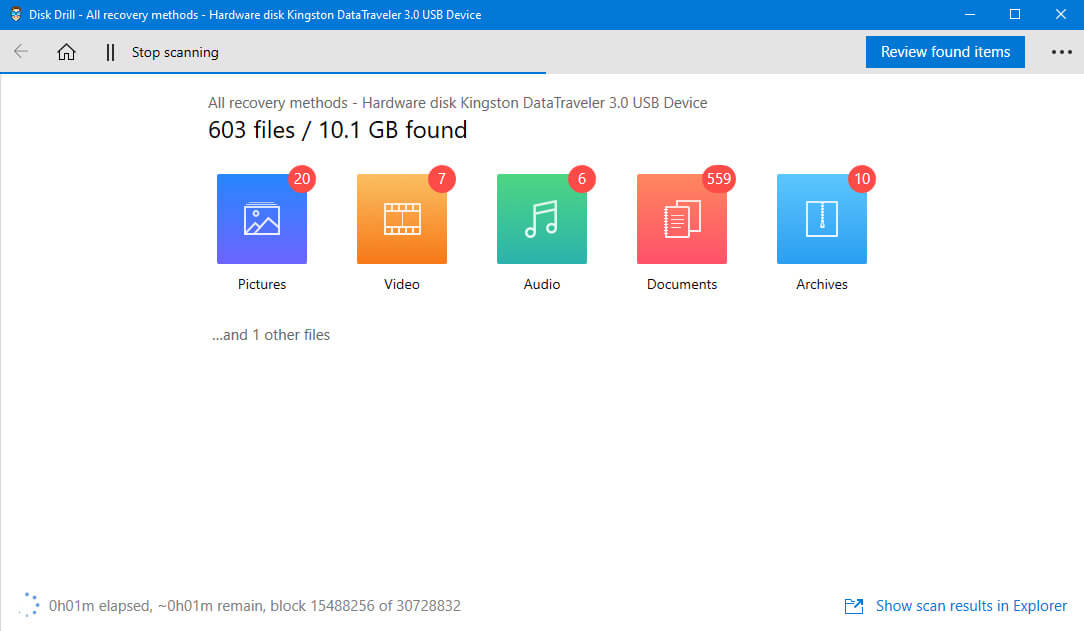
- Preview the files that can be recovered. You can limit the scan results so you only see the Excel files that have been found.
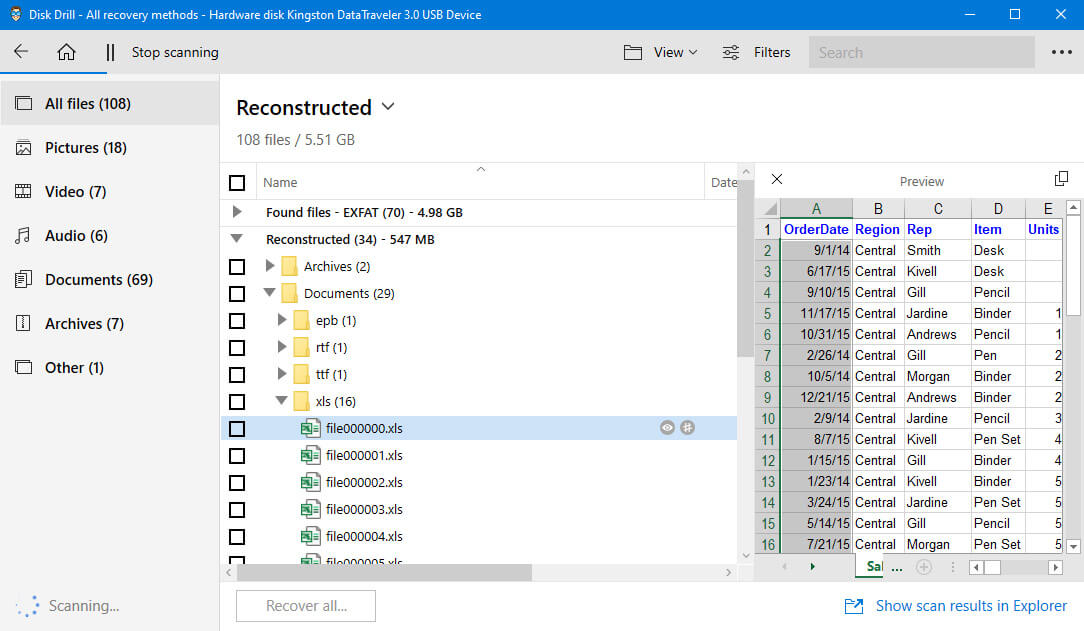
- Select the files you want to retrieve and choose a safe location to save them.
- Click the Restore button to get your lost files back.
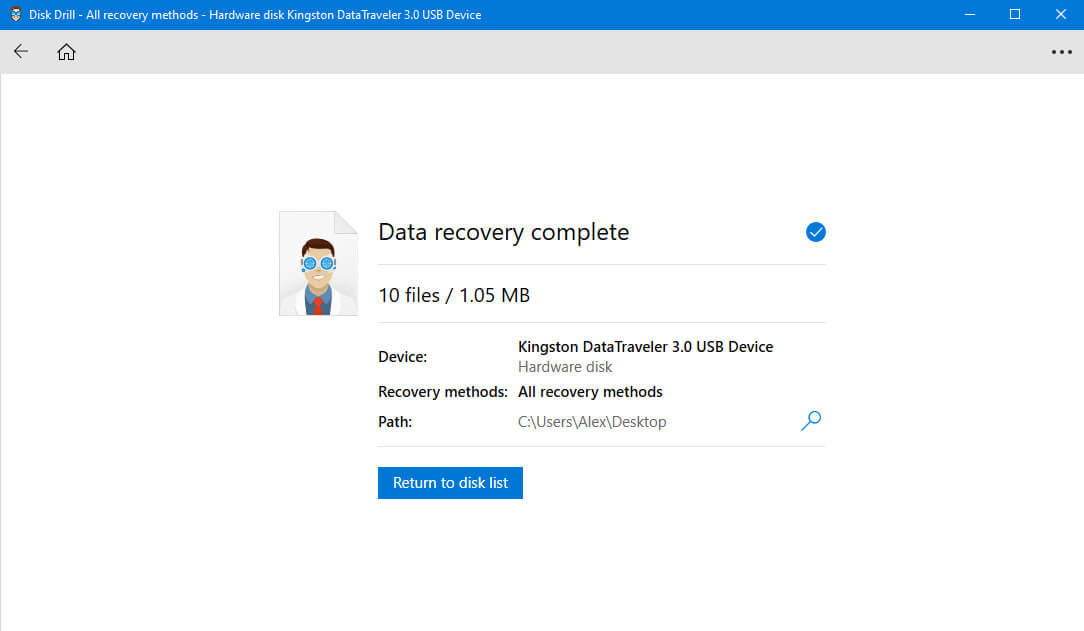
Most other data recovery programs work similarly, though not many are as easy to use as Disk Drill. Some other recovery programs you might want to consider for a Windows 10 recovery of lost Excel files include:
- Recuva;
- R-Studio;
- Stellar Data Recovery Professional;
- PhotoRec.
Whichever solution you choose, you will achieve the best results by acting quickly before deleted data is overwritten. We recommend you stop using the storage device that held the Excel files as soon as you realize there is an issue. Don't save any new data to that device until the recovery is complete.
Recovering an Overwritten Excel File
You may be able to use the recover Previous Versions facility of Windows 10 to revert to an older copy of a file using the following procedure. For this method to work, you need to have System Restore enabled which will create restore points from which the previous versions are recovered.
- Open File Explorer.
- Go to the file or folder you wish to recover.
- Right-click the item and select the Previous Versions option.
- Select the version you want to recover.
- Click on the Restore button.
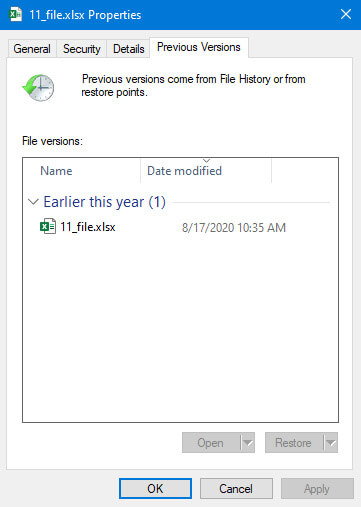
Are There Differences in the Recovery Process for Different Excel Versions?
Yes, there are differences in the recovery process in Excel 2007/2010/2013/2016/ and Office 365. The major difference is the addition of the AutoSave feature to the well-known AutoRecover option that has been a part of Microsoft Office products for years. While you can still use AutoRecover to get back unsaved data, AutoSave keeps your files constantly updated when you use Office 365.
When you use Office 365, copies of your work are automatically saved by default. There is one change in your workflow that must be done to use this feature effectively. Instead of using File > Save As after making changes to an original document, you should use File > Save a Copy. This ensures that the original file will not be overwritten as AutoSave protects your data.
FAQ
Excel automatically starts File Recovery mode and attempts to reopen and simultaneously repair the workbook. You can also try to repair a reoccupied Excel file manually using the following procedure.
- Click Open on the File tab.
- Select the corrupted workbook that you want to open.
- Click the arrow next to the Open button and select Open and Repair.
- Select Repair to recover as much of the workbook's data as possible. You can also choose to Extract Data to salvage values and formulas from the damaged spreadsheet.
Without software, the best way to recover a deleted Excel file is with the Windows Recycle Bin or a backup. Both methods are covered in detail in an earlier section of this article.
You may be successful using the procedure for recovering previous versions of a file that is detailed above or from a backup. Disk recovery programs may not be able to gain the necessary level of access on the network drive to perform a successful recovery.
Conclusion
There are many ways to get back lost or deleted Excel files. In most cases, the recovery will have a better chance of success if you act quickly after discovering the file has an issue. Stop using the storage device that contained the file until you have completed the recovery to avoid overwriting or further corrupting the data you wish to restore. We hope this information helps you recover your valuable Excel files and avoids losing important documents.
Robert Agar is the Content Writer & Managing Editor for Handy Recovery. Robert brings over 30 years of experience in data storage, security, compliance, backup, and recovery to the HandyRecovery team. Several years ago, he turned his attention from hands-on technical roles to develop a career as a freelance writer concentrating on technology and its impact on society. Areas of focus include the cloud, data recovery, artificial intelligence, and industrial automation. Robert writes for several popular data recovery portals, such as PandoraRecovery or CleverFiles.
Andrey Vasilyev is an Editorial Advisor for Handy Recovery. Andrey is a software engineer expert with extensive expertise in data recovery, computer forensics, and data litigation. Andrey brings over 12 years of experience in software development, database administration, and hardware repair to the team.
How to Recover Deleted Excel Sheet in Windows 10
Source: https://www.handyrecovery.com/recover-deleted-excel-file-on-windows/#:~:text=Launch%20Excel%20and%20go%20to,it%20to%20open%20the%20document.